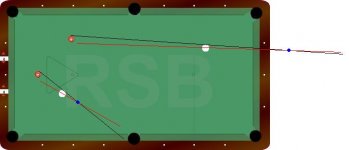Along the lines of what Joey proposed I have set up a test in the diagram below.
Not really so much a test, but a method to get some feedback from 90/90 users to see if these shots give them some insights into how they adjust the pivot and bridge to make these shots.
The long shot is similar to the one Spidey performed on video. Tracking the cue we could see the effective pivot was 10 or so inches back from his bridge so the top of the bridge shifted left several mm. This is about what we would expect for a longish straightish shot as seen in the diagram below.
For the shorter shot with higher cut angle, the required pivot should be shorter than the actual bridge length, so I'd expect the player (if right handed) to have to shift the bridge a couple of mm right.
I think it is pretty well proven that the upper bridge needs to shift (the base may stay in the same place) according to various lengths of shot and cut angles. These will also change according to the bridge length a player uses. The question for me has always been HOW this bridge shift/pivot adjustment is executed by the player. My guess has been that it is by feel.
Anyway, please try these shots a few times and take note of the upper bridge shift and the effective pivot if you can and let me know your thoughts. A video showing the cue and bridge from behind would be of great use if anyone could produce one.
Perhaps it is because I pivot so often using BHE that I am highly sensitive to bridge movement and the pivot length. For others, I suspect they can pivot to where they see the line with some slight lateral bridge movement and not be aware of it. Hence their using feel to get to the line they see without realizing it. That's my theory for now anyway

Colin
